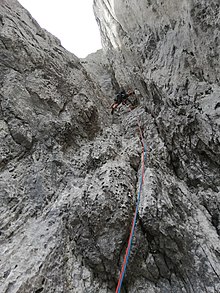Jewelry fireplace
The jewelry chimney , or Direct East Chimney , is a climbing route in the middle section of the Fleischbank -Estwand in the Austrian Kaiser Mountains .
The route was first climbed in 1949 and is considered one of the most beautiful chimney climbing tours in the Alps. A chimney of various widths leads through the limestone rock over around 300 meters in altitude. The difficulty is VI according to UIAA .
Climbing history
On September 19, 1930, Peter Aschenbrenner and Hans Lucke found a passage in the middle section of the 300 m high east wall. The two climbed in the fall line of a rock chimney that ran through almost the entire wall. They did not go into the chimney, however, but left the fall line to the left when they had recognized the difficulties of the smooth gullet. Via Platten they reached a large gorge through which the “ Aschenbrenner Chimney ” leads to the north ridge. This route, known as Asche-Luck , was henceforth the most difficult rock tour in the Kaiser Mountains.
Due to the lack of information options at that time, such as route descriptions and course sketches, some rope teams failed to cross the Asche-Luck to the left when they tried again , got too high in the chimney and had to turn around in the wide and smooth chimney. This also happened to Hermann Buhl and Waldemar Gruber at Pentecost 1943 when they climbed into the chimney following the natural rock conditions. They almost unconsciously would have succeeded in the first ascent of the chimney if Buhl had not fallen and injured 50-60 meters from an erupting boulder. The two then retreated into the valley.
On June 26, 1949, the three Austrians Marcus Schmuck , Rudolf Bardodej and Hadwin Pollack wanted to climb the Asche-Luck route , but were irritated by the abseil hooks and hooks of other rope teams and also got caught in the chimney. However, they managed to climb through with difficult splay climbing and sometimes without any means of securing. Then they had to bivouack on the north ridge. They then named the chimney after Marcus Schmuck, who had overcome most of the difficulties in the lead climb .
The second ascent was not made until 1960 by Jörg Lehne and Siegfried Löw , the third ascent in 1962 by Pit Schubert and Klaus Werner. As the fourth rope team, Wulf Scheffler and Gert Uhner managed to climb through in 1963, the first soloist was the South Tyrolean Heini Holzer in 1968 . In 1970 Werner Bittner and Klaus Werner made the first winter ascent . In 1980, Andrea Eisenhut became the first woman to climb the route. Further inspections followed a. by Peter Habeler , Reinhard Schiestl and Hans Bärnthaler .
swell
- Der Bergsteiger , July 1979 edition, pp. 429-433
literature
- Alpine club guide Kaisergebirge extreme , Bergverlag Rother
- Climbing guide Wilder Kaiser , Panico Alpinverlag
Web links
Coordinates: 47 ° 34 ′ 9 ″ N , 12 ° 19 ′ 3 ″ E

